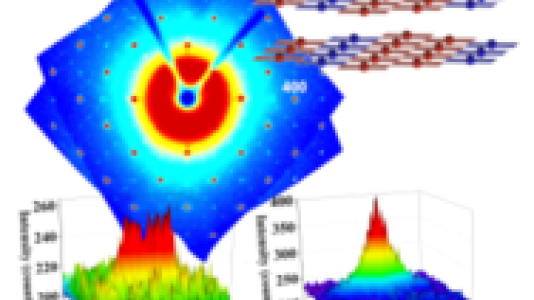
A unique, paradoxical ground state of the layered nickelate La4Ni3O8 is associated with charge stripe ordering. Using single crystal synchrotron x-ray diffraction, we find that the stripes are stacked directly on top of one another within nickel oxide trilayers, yet staggered between successive trilayers results in which the electrostatic building principle is respected at long range but violated at short distances. Notably, the charge stripe superlattice propagation vector, q=(⅔, 0, 1), corresponds with that found in the related ⅓-hole doped single layer nickelate, La5/3Sr1/3NiO4 (formal charge state, Ni2.33+) with orientation at 45° to the Ni-O bonds, indicating that the 1/3 fractional charge in both of these compounds controls the charge condensation behavior.
Competition between localized and itinerant electrons in highly correlated materials can lead to myriad insulating ground states, including spatially inhomogeneous yet ordered charge superlattices. In layered transition metal oxides, such charge order is known to take the form of stripes, which typically arrange themselves in staggered formations to minimize their mutual Coulomb repulsion. To date, these charge-stripe phases in nickel oxides have been restricted to two-dimensional materials in which single, isolated sheets made up of corner-sharing NiO6 octahedra hosts the stripe.
Now, a group of Argonne scientists from the Materials Science Division and the Advanced Photon Source have found that these charge stripes can exist even when the transition metals have been stripped of two oxygen ligands and stacked into a trilayer structure of corner-shared NiO4 square planes, demonstrating the robustness of this charge-stripe state and suggesting the possibility of links to copper oxide high temperature superconductivity.
The team began by growing the first reported single crystals of the target materials, La4Ni3O8 , using a high pressure oxygen growth technique. In La4Ni3O8, each Ni atom is surrounded by four oxygens in a square planar geometry, sharing corners to form infinite sheets. These sheets are closely grouped into trilayers in the structure. With two Ni1+ and one Ni2+ per formula unit, there is one extra positive charge, or hole, for every three nickels. Using synchrotron x-ray diffraction at APS Beamline 15-ID-D, the team identified the appearance of superlattice reflections at low temperature. The position of these reflections pointed to a three-fold expansion of the unit cell dimension, consistent with ordering of the one extra hole for every three Ni sites. Modeling of the x-ray intensity pattern led the team to conclude that the extra holes were organizing themselves into stripes and that these stripes stacked directly on top of one another within nickel oxide trilayers, yet staggered themselves between successive trilayers. A unique, paradoxical ground state results in which the Coulomb repulsion between stripes is reduced at long range but not at short length scales. Furthermore, the charge stripe pattern corresponds with that found in the related single layer nickelate, La5/3Sr1/3NiO4 (also with 1 extra hole for every 3 Ni ions) indicating that the 1/3 fractional charge in both of these compounds controls the charge condensation behavior. The team notes that their square planar Ni1+ compounds have the same electronic configuration as that found in high-Tc superconducting cuprates, suggesting that these trilayer materials may offer routes to other superconductors or new insights on existing ones.
Publication: “Stacked Charge Stripes in the Quasi-Two-Dimensional Trilayer Nickelate La4Ni3O8,” Junjie Zhang, Yu-Sheng Chen, D. Phelan, Hong Zheng, M. R. Norman, and J. F. Mitchell Proc. Natl. Acad. Sci. 113(32), 8945 (2016) doi: 10.1073/pnas.1606637113